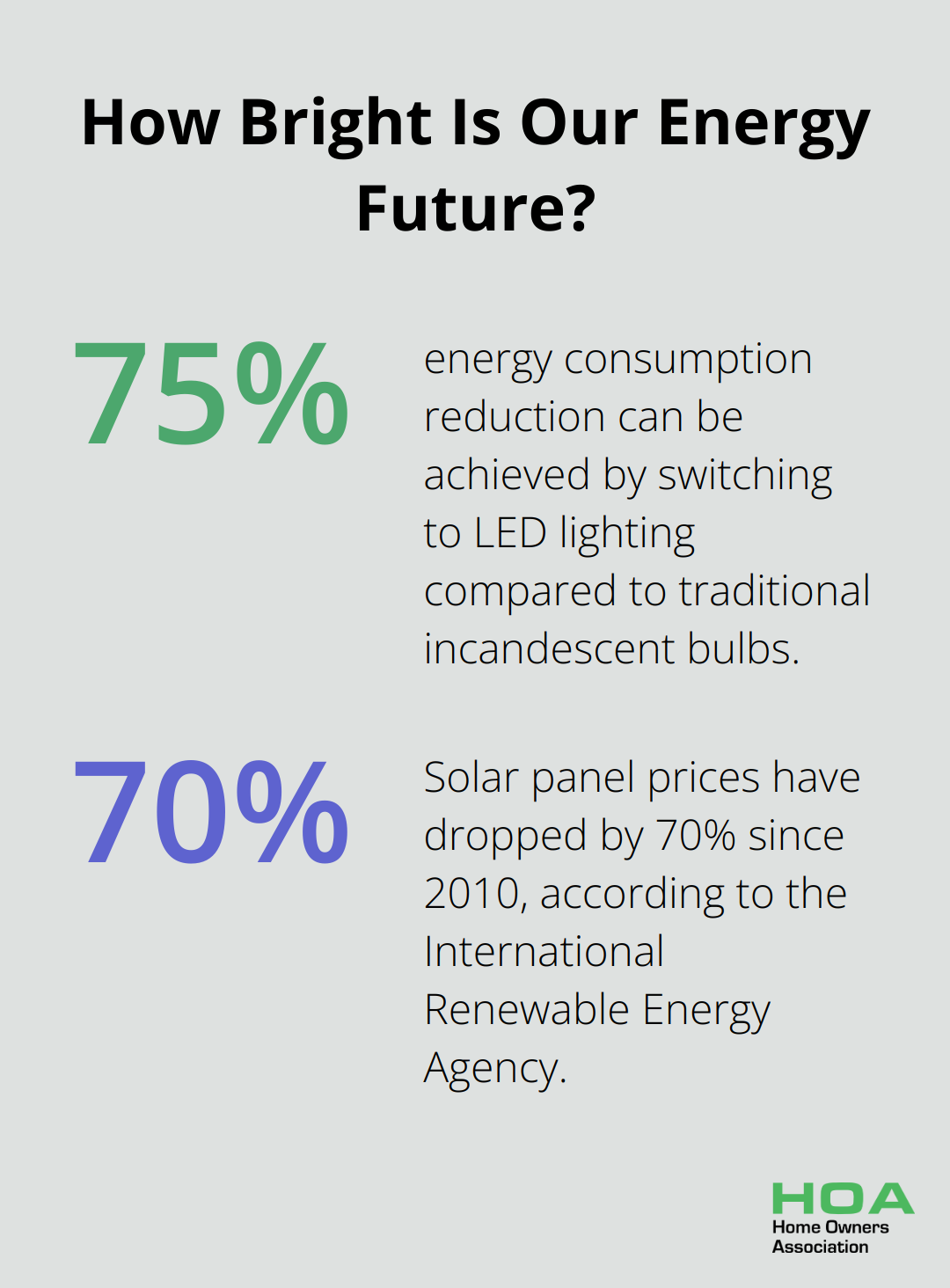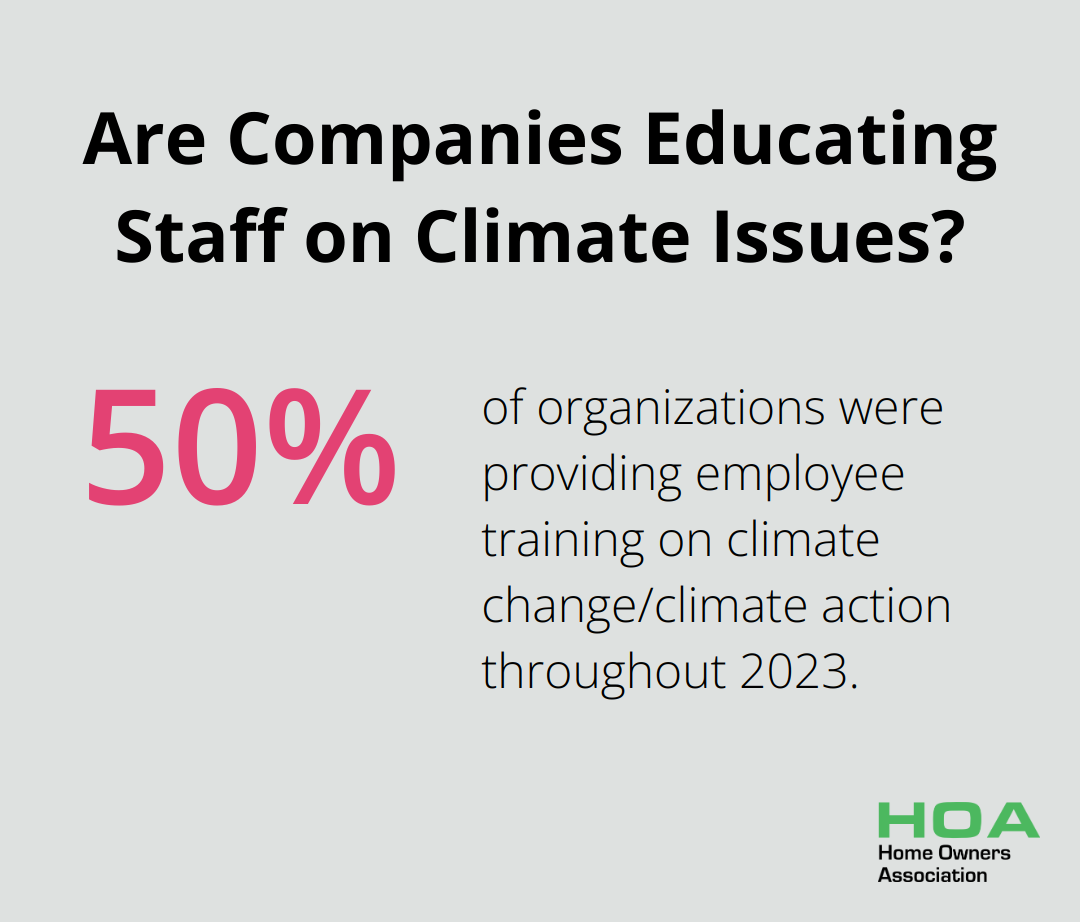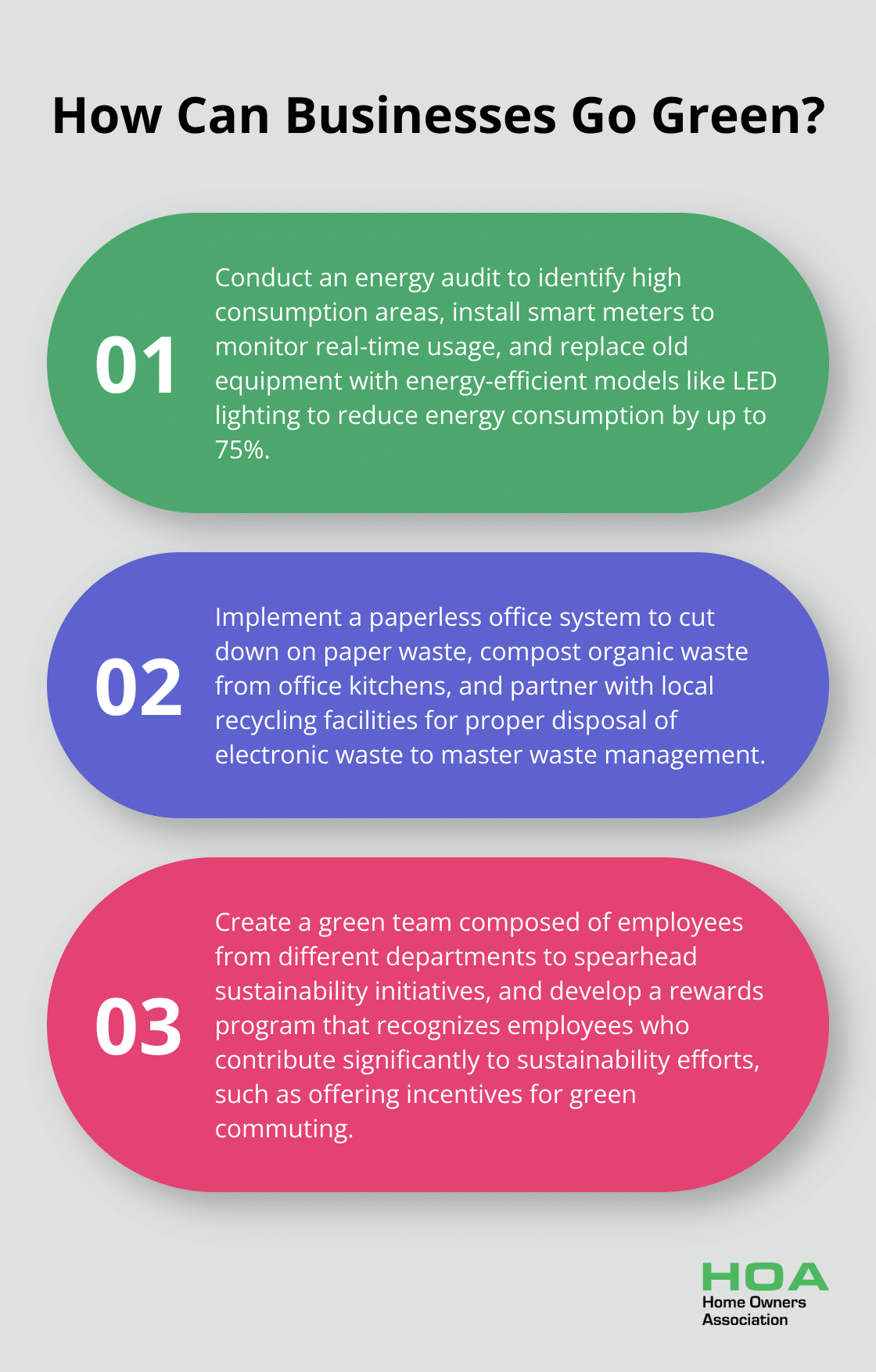
At Home Owners Association, we believe that green is building sustainable business practices. The shift towards eco-friendly operations is no longer optional; it’s a necessity for long-term success.
Businesses that prioritize sustainability not only reduce their environmental impact but also gain a competitive edge in the market. This blog post explores practical strategies for implementing sustainable practices, fostering a culture of environmental responsibility, and measuring the impact of these efforts.
How We Implement Eco-Friendly Operations
At Home Owners Association, we’ve witnessed the transformative power of eco-friendly operations in businesses. Let’s explore practical steps to make your operations more sustainable.
Slash Energy Consumption
One of the most effective ways to reduce your environmental impact is to cut energy use. Start with an energy audit to identify high consumption areas. CBI’s efforts focus on highly innovative, cost-effective, energy-saving measures that produce significant energy savings and improve building performance.

Install smart meters to monitor energy use in real-time. This allows you to identify peak usage times and adjust accordingly. Replace old equipment with energy-efficient models. For example, switching to LED lighting can reduce energy consumption by up to 75% compared to traditional incandescent bulbs.
Consider investing in renewable energy sources. Solar panels have become increasingly affordable (prices have dropped by 70% since 2010, according to the International Renewable Energy Agency). Even if you can’t install your own system, many utility companies offer green energy options.
Master Waste Management
Effective waste management extends beyond recycling. Try to reduce waste at the source. Implement a paperless office system to cut down on paper waste. The Environmental Protection Agency reports that the average office worker uses 10,000 sheets of paper per year.
Compost organic waste from office kitchens or cafeterias. This not only reduces landfill waste but also creates nutrient-rich soil for landscaping. Partner with local recycling facilities to ensure proper disposal of electronic waste (which often contains hazardous materials).
Encourage employees to use reusable containers and utensils. Provide water filtration systems to reduce plastic bottle waste. These small changes can add up to significant waste reduction over time.
Green Your Supply Chain
A truly sustainable business considers its entire supply chain. Start by assessing your current suppliers’ environmental practices. Look for certifications like ISO 14001, which indicates a commitment to environmental management.
Opt for local suppliers when possible to reduce transportation emissions. Studies estimate that processed food in the United States travels over 1,300 miles, and fresh produce travels over 1,500 miles, before being consumed. By choosing local options, you can significantly cut this distance.
Consider the lifecycle of products you purchase. Look for items made from recycled materials or those that can be easily recycled at the end of their life. Implement a vendor code of conduct that includes environmental standards, ensuring your suppliers align with your sustainability goals.
These eco-friendly operations not only reduce your environmental impact but also set your business up for long-term success. As we move forward, it’s essential to create a culture that supports and nurtures these sustainable practices.
Fostering a Sustainability Mindset
At Home Owners Association, we understand that creating a culture of sustainability is essential for long-term success. It’s not enough to implement eco-friendly practices; you need to embed sustainability into the very fabric of your organization. Here’s how to cultivate a sustainability mindset among your team.
Educate and Engage Employees
Provide comprehensive sustainability training for all employees. A study found that 50% of organizations were providing employee training on climate change/climate action throughout 2023. This training should cover the basics of environmental issues, your company’s sustainability goals, and practical ways employees can contribute.

Organize workshops and lunch-and-learn sessions featuring experts in various sustainability fields. These events inspire employees and provide fresh perspectives on environmental challenges. For instance, invite local conservation groups to discuss regional environmental issues and how businesses can help.
Create a green team or sustainability committee composed of employees from different departments. This team can spearhead initiatives, gather ideas from colleagues, and act as sustainability ambassadors within the organization.
Align Sustainability with Company Values
Integrate sustainability into your company’s mission statement and core values. This sends a clear message that environmental responsibility is a fundamental part of your business identity. Review and update your company policies to reflect this commitment.
Lead by example. Ensure that leadership visibly supports and participates in sustainability initiatives. When executives actively engage in green practices, it motivates employees at all levels to follow suit.
Communicate your sustainability efforts regularly through internal newsletters, company-wide meetings, and dedicated sustainability reports. Transparency about both successes and challenges fosters trust and encourages ongoing engagement.
Incentivize Green Practices
Develop a rewards program that recognizes and celebrates employees who contribute significantly to sustainability efforts. This could include monetary bonuses, extra vacation days, or public recognition.
Incorporate sustainability metrics into performance reviews. This reinforces the importance of environmental responsibility and ensures that it’s not seen as an optional add-on but an integral part of job performance.
Consider implementing a green commuting program. Offer incentives for employees who use public transportation, carpool, bike, or walk to work. Businesses are rewarding employees for leaving their cars at home, providing cities with a powerful new tool in their quest to reduce car use.
The cultural shift towards sustainability is a journey that requires continuous effort and commitment. As we move forward, it’s important to measure and report on these sustainability efforts to track progress and maintain momentum. Let’s explore how to effectively quantify and communicate your organization’s environmental impact in the next section.
How We Measure Sustainability Success
At Home Owners Association, we understand the importance of tracking and reporting sustainability efforts. This process drives continuous improvement and demonstrates our commitment to stakeholders. Let’s explore practical ways to quantify and communicate environmental impact.
Select the Right Key Performance Indicators
Choosing appropriate Key Performance Indicators (KPIs) is vital for measuring sustainability progress. We focus on metrics that align with specific goals and industry standards. For example, if reducing energy consumption is a priority, we track kilowatt-hours used per square foot or per unit of production.

Common sustainability KPIs include:
-
Total energy consumption and percentage from renewable sources
-
Water usage and recycling rates
-
Waste generation and diversion from landfills
-
Carbon emissions (Scope 1, 2, and 3)
-
Percentage of suppliers meeting sustainability criteria
The Global Reporting Initiative (GRI) provides a comprehensive set of sustainability reporting standards that can guide KPI selection. The GRI Standards are regularly reviewed to ensure they reflect global best practices for sustainability reporting, helping thousands of organizations around the world.
Implement Effective Measurement Systems
To accurately track KPIs, we invest in robust data collection and management systems. Many companies turn to specialized software solutions to streamline this process. The CDP (formerly Carbon Disclosure Project) reports that 99% of companies plan to invest in technologies for better ESG reporting.
We consider implementing an Environmental Management System (EMS) like ISO 14001. This internationally recognized standard provides a framework for measuring and improving environmental performance. Over 300,000 organizations worldwide are certified to ISO 14001 (according to ISO).
Communicate Progress to Stakeholders
Transparency is key when reporting sustainability efforts. We publish an annual sustainability report that details our goals, progress, and challenges. This report is easily accessible on our website and shared with employees, customers, and investors.
We use clear, jargon-free language and visual aids (like graphs and infographics) to make our data more digestible. The Sustainability Accounting Standards Board (SASB) offers industry-specific guidelines for reporting financially material sustainability information to investors.
We don’t shy away from discussing areas where we’ve fallen short. Acknowledging challenges and outlining plans for improvement demonstrates authenticity and commitment to continuous progress.
We consider having our sustainability report independently verified. A study by the Centre for Sustainability and Excellence found that companies with externally assured sustainability reports perform better financially.
Measuring and reporting sustainability efforts is an ongoing process. We regularly review and refine our KPIs and reporting methods to ensure they remain relevant and effective. Quantifying environmental impact and communicating it clearly not only drives internal improvements but also strengthens our reputation as a responsible business leader.
Final Thoughts
Building sustainable business practices is essential for long-term success in today’s business landscape. Companies that prioritize environmental responsibility often experience improved brand reputation, increased customer loyalty, and enhanced competitiveness. These organizations also position themselves to navigate increasingly stringent environmental regulations and meet the growing demand for sustainable products and services.

At Home Owners Association, we believe that green is building sustainable business practices. We serve homeowners in Melbourne, Australia, and promote sustainability in home improvement projects. Our members benefit from trade pricing on eco-friendly materials and expert advice on sustainable home solutions.
The time to act is now. We encourage all businesses to embrace sustainability as a core strategy for growth and resilience. Companies that take steps to reduce their environmental impact today secure a brighter, more sustainable future for themselves and our planet.





